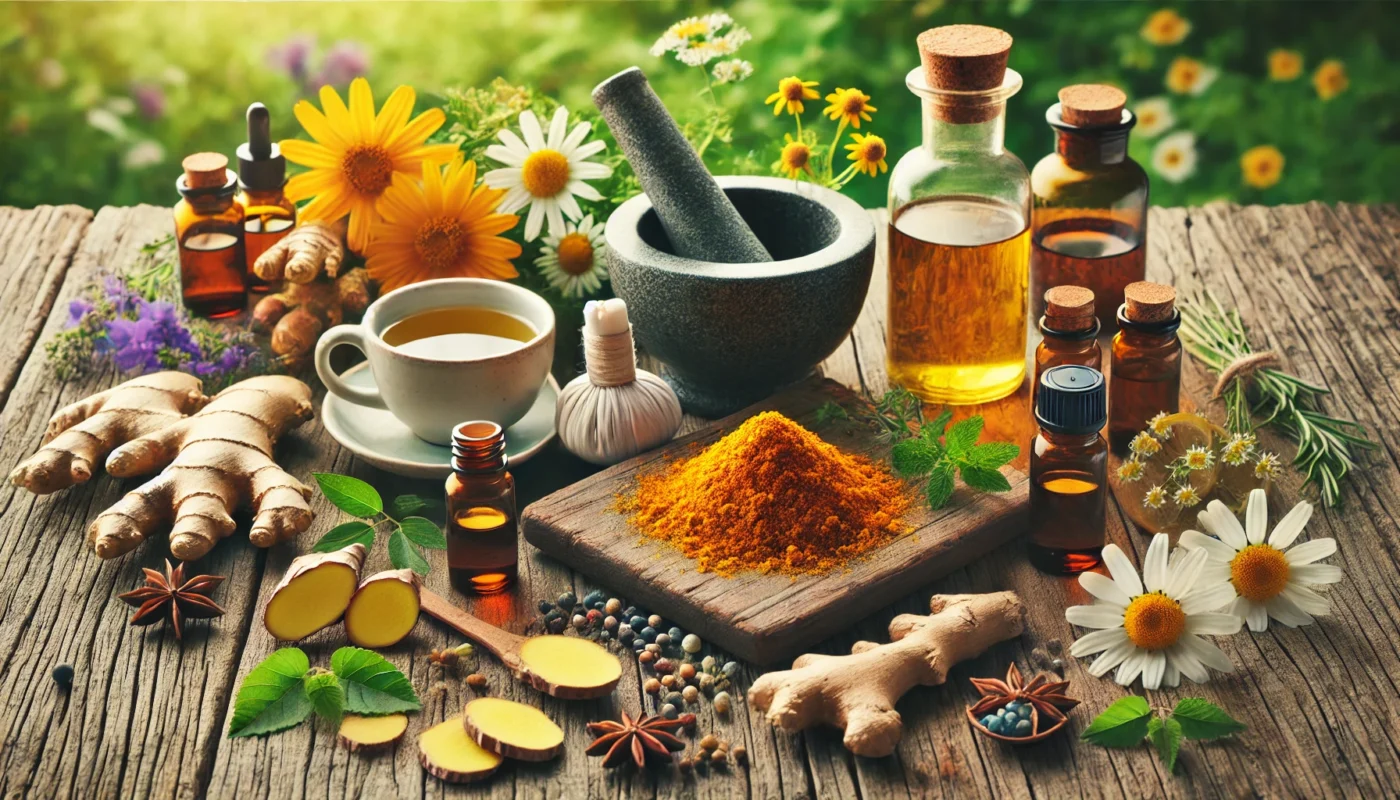In an era where the medical community is continuously exploring alternative approaches to health, herbal pain relief stands out as a viable option for those seeking to manage pain naturally. With a rich history spanning centuries, herbal remedies have been used across various cultures to alleviate pain, boost health, and improve overall wellbeing. This article delves into the benefits of herbal pain relief, offering insights and practical advice for those interested in natural remedies for pain.
You may also like: Exploring Alternative Treatments for Pain Relief
Understanding Herbal Pain Relief
Herbal pain relief involves using plant-based substances to alleviate discomfort and manage pain. These substances, often referred to as natural painkillers or herbal analgesics, interact with the body in diverse ways to reduce pain and inflammation. While traditional medicine often relies on pharmaceuticals, herbal remedies offer a natural alternative that can be equally effective for certain conditions.
The Science Behind Herbal Remedies
Scientific research has increasingly supported the efficacy of herbal remedies in pain management. For instance, studies have shown that certain herbs contain compounds that have analgesic (pain-relieving) and anti-inflammatory properties. These compounds work by targeting the body’s pain pathways and reducing the perception of pain.
Researchers have identified specific molecules within herbs that interact with receptors in the human body, effectively blocking pain signals. This interaction mimics the action of some synthetic drugs but often without the accompanying side effects. As science progresses, the understanding of these processes allows for more targeted and effective use of herbal remedies.
Furthermore, advancements in technology have enabled the extraction and concentration of active compounds, enhancing the potency and efficacy of herbal treatments. These developments have fueled a growing interest in integrating herbal remedies into mainstream medicine, fostering a more holistic approach to pain management.
Historical Context and Cultural Significance
The use of herbal remedies dates back to ancient civilizations, where plants were the primary source of medicine. In cultures such as Traditional Chinese Medicine (TCM) and Ayurveda, herbs have been central to healing practices for thousands of years. The historical context of herbal medicine reveals a treasure trove of knowledge and traditions that inform modern practices.
Cultural significance plays a crucial role in the perception and acceptance of herbal remedies. Many indigenous cultures still rely heavily on plant-based treatments, passing down knowledge through generations. This rich heritage not only underscores the effectiveness of herbal remedies but also highlights the importance of preserving traditional wisdom in contemporary health practices.
Comparing Herbal and Pharmaceutical Approaches
While pharmaceuticals are highly effective in managing acute and severe pain, they often come with a range of side effects, including dependency and organ damage. Herbal remedies, on the other hand, offer a more sustainable approach to pain management. They focus on addressing the root cause of pain rather than merely masking symptoms.
In comparing the two approaches, one must consider factors such as safety, accessibility, and long-term health effects. Herbal remedies tend to be more accessible and affordable, often requiring fewer resources for production and distribution. However, it is essential to recognize that not all pain conditions can be effectively managed with herbs alone, and a balanced approach may be necessary.

Benefits of Herbal Pain Relief
Herbal pain relief offers a multitude of benefits that extend beyond mere symptom management. These advantages make it an attractive option for individuals seeking a more holistic approach to health and wellness.
Reduced Side Effects
Unlike some synthetic drugs, herbal remedies often have fewer side effects, making them a safer option for long-term use. This safety profile is particularly beneficial for individuals with chronic pain conditions who require ongoing management.
The body’s ability to metabolize and eliminate natural compounds from herbs generally results in fewer adverse reactions. This is especially important for vulnerable populations, such as the elderly or those with compromised immune systems, who may be more susceptible to the side effects of conventional medications.
In addition, the reduced risk of dependency associated with herbal remedies offers peace of mind to those concerned about the potential for addiction with certain pharmaceutical painkillers. By minimizing side effects, individuals can maintain a higher quality of life while managing their pain effectively.
Holistic Health Improvement
Herbal remedies not only target pain but also contribute to overall health by boosting the immune system and improving bodily functions. Many herbs possess a range of bioactive compounds that offer multiple health benefits.
For example, herbs like ginger and turmeric are known for their antioxidant properties, which help combat oxidative stress and support cellular health. This holistic approach ensures that the body is not only managing pain but also enhancing its overall resilience and vitality.
By focusing on the whole body rather than isolated symptoms, herbal remedies promote balance and harmony within the body’s systems. This integrative perspective aligns with the principles of holistic health, which emphasize the interconnectedness of physical, mental, and emotional wellbeing.
Accessibility and Cost-effectiveness
Many herbs are widely available and can be a more cost-effective solution compared to prescription medications. This accessibility makes herbal remedies an appealing choice for individuals seeking affordable healthcare options.
The ability to grow certain herbs at home further enhances their cost-effectiveness, allowing individuals to cultivate their own natural medicine cabinet. This self-sufficiency empowers people to take charge of their health and reduce their reliance on external healthcare resources.
Moreover, the global trade of herbs has increased their availability in various forms, including teas, extracts, and supplements. This diversity of options enables consumers to choose the form that best suits their needs and preferences, ensuring that herbal pain relief is both practical and economical.
Exploring Popular Herbal Remedies for Pain
Let’s explore some of the most effective herbal remedies for pain relief, each backed by scientific research and traditional use.
Turmeric
Turmeric, a vibrant yellow spice, is renowned for its anti-inflammatory properties. Curcumin, the active compound in turmeric, has been shown to reduce inflammation and pain, especially in conditions like arthritis. To maximize absorption, it’s recommended to consume turmeric with black pepper.
Beyond its pain-relieving capabilities, turmeric is celebrated for its role in supporting liver health and aiding digestion. Its versatility makes it a staple in both culinary and medicinal applications. Incorporating turmeric into daily meals, such as curries and soups, not only enhances flavor but also provides consistent health benefits.
For those who prefer supplements, curcumin capsules offer a concentrated dose of the active compound, ensuring maximum therapeutic effects. However, individuals should consult with healthcare providers to determine the appropriate dosage and avoid potential interactions with other medications.
Willow Bark
Often referred to as “nature’s aspirin,” willow bark contains salicin, a compound similar to aspirin. It’s particularly effective for back pain, osteoarthritis, and headaches. However, it should be used with caution in individuals sensitive to aspirin.
The historical use of willow bark dates back to ancient Greece and Egypt, where it was employed to reduce fever and inflammation. Its efficacy in pain management has been well-documented, making it a popular choice for those seeking natural alternatives to over-the-counter painkillers.
While willow bark is available in various forms, including teas and tinctures, individuals should be mindful of their dosage to avoid gastrointestinal irritation. As with any herbal remedy, consulting with a healthcare professional is advised to ensure safe and effective use.
Ginger
Ginger is another powerful herb known for its anti-inflammatory and analgesic properties. It can help alleviate pain related to osteoarthritis and menstrual discomfort. Incorporating ginger into your diet or taking it as a supplement can provide significant pain relief.
In addition to its pain-relieving qualities, ginger is celebrated for its ability to soothe digestive issues and reduce nausea. Its warming properties make it an ideal remedy for colds and flu, providing comfort and support during illness.
Fresh ginger can be easily added to teas, smoothies, and stir-fries, offering a flavorful way to integrate its health benefits into daily life. For those seeking a more potent effect, ginger supplements provide a convenient and effective alternative, ensuring consistent intake of its active compounds.
Capsaicin
Derived from chili peppers, capsaicin is a natural pain reliever that works by depleting substance P, a neuropeptide that transmits pain signals. Topical creams containing capsaicin are commonly used for nerve pain and arthritis.
The use of capsaicin extends beyond pain relief, as it has been shown to boost metabolism and promote weight loss. Its thermogenic properties stimulate the body’s heat production, aiding in fat burning and energy expenditure.
When using capsaicin creams, individuals should apply them sparingly to avoid irritation or burning sensations. Starting with a small amount and gradually increasing application can help the body acclimate to its effects, ensuring a comfortable and effective pain management experience.
Valerian Root
Valerian root is often used as a natural treatment for pain associated with muscle spasms and tension. It acts as a muscle relaxant and can be especially beneficial for those suffering from conditions like fibromyalgia.
Beyond its pain-relieving properties, valerian root is renowned for its calming effects, making it a popular choice for individuals experiencing anxiety or sleep disturbances. Its soothing qualities promote relaxation and stress reduction, supporting mental and emotional wellbeing.
Valerian root is typically consumed as a tea or in supplement form. To maximize its benefits, individuals should consider incorporating it into their nightly routine, creating a calming ritual that fosters rest and recovery.
White Willow Bark
White willow bark has been used for centuries to reduce fever and inflammation. It contains salicin, which the body converts into salicylic acid, a chemical similar to aspirin.
The analgesic effects of white willow bark make it a reliable option for managing pain associated with inflammatory conditions. Its gentle action on the body ensures that it is well-tolerated by most individuals, offering a natural and effective alternative to synthetic painkillers.
In addition to its pain-relieving benefits, white willow bark supports cardiovascular health by promoting healthy blood flow and reducing the risk of clot formation. This dual action makes it a valuable addition to any natural health regimen, providing comprehensive support for overall wellbeing.
How to Use Herbal Remedies Safely
While herbal remedies offer numerous benefits, it is essential to use them safely and effectively.
Consultation with Healthcare Professionals
Before incorporating herbal remedies into your pain management plan, consult with a healthcare professional, especially if you’re taking other medications or have underlying health conditions. This ensures that the herbs won’t interfere with your current treatment plan.
Healthcare providers can offer personalized advice based on your unique health needs, ensuring that the herbal remedies complement your existing treatments. By working collaboratively with professionals, you can create a comprehensive and safe approach to pain management.
In addition, healthcare professionals can help identify potential allergies or sensitivities to specific herbs, minimizing the risk of adverse reactions. Their expertise provides valuable guidance in navigating the complexities of herbal medicine.

Proper Dosage and Administration
Adhering to recommended dosages is crucial to avoid potential side effects. Herbal supplements often come with specific dosage instructions, and it’s important to follow these guidelines carefully.
Understanding the appropriate form and concentration of herbal remedies is essential for safe usage. Whether in the form of teas, tinctures, or capsules, each preparation may require different dosing considerations. Familiarizing yourself with these variations ensures that you receive the intended benefits without unintended consequences.
Additionally, keeping track of your herbal intake can help monitor its effectiveness and identify any patterns or changes in your symptoms. This proactive approach allows for timely adjustments and fosters a more personalized and effective pain management strategy.
Monitoring and Adjusting
Pay attention to how your body responds to herbal remedies. If you experience any adverse effects or if the desired pain relief is not achieved, consult with a healthcare provider to adjust your regimen accordingly.
Regular monitoring of your symptoms and overall health ensures that the herbal remedies are meeting your needs effectively. By remaining attuned to your body’s signals, you can make informed decisions about your treatment plan and optimize your health outcomes.
Adjustments may include changing the dosage, trying different herbs, or incorporating complementary therapies. This flexibility allows for a dynamic and responsive approach to pain management, ensuring that you receive the most benefit from your chosen remedies.
Integrating Herbal Pain Relief into Your Routine
Incorporating herbal remedies into your daily routine can be simple and effective. Here are some practical strategies:
Dietary Inclusion
Add herbs like turmeric and ginger to your meals for a consistent intake of pain-relieving compounds. These culinary herbs not only enhance flavor but also provide ongoing support for your health and wellbeing.
Experimenting with recipes that incorporate these herbs can be a fun and rewarding way to explore their benefits. From golden milk lattes to ginger-infused stir-fries, the possibilities are endless, offering delicious ways to support your pain management goals.
By making these herbs a staple in your kitchen, you can seamlessly integrate their health benefits into your daily life, ensuring consistent support for your pain management efforts.
Herbal Supplements
Consider high-quality herbal supplements for a convenient and concentrated dose of beneficial compounds. Supplements offer a practical solution for those who may not have time to prepare herbal remedies from scratch.
When choosing supplements, prioritize quality and purity to ensure that you receive the full spectrum of benefits without harmful additives. Researching reputable brands and consulting with healthcare professionals can help you make informed choices that align with your health goals.
Supplements provide a reliable and efficient way to incorporate herbal remedies into your routine, offering consistent and measurable support for your pain management strategy.
Topical Applications
Use creams and ointments containing herbal extracts like capsaicin for targeted pain relief. These topical applications provide direct and immediate relief to affected areas, making them an excellent choice for localized pain.
Applying these products as part of your daily routine can enhance their effectiveness and support ongoing pain management efforts. By incorporating them into your self-care practices, you can create a holistic approach that addresses both internal and external aspects of pain relief.
Herbal Teas
Enjoy herbal teas made from pain-relieving herbs such as ginger or valerian root for both relaxation and pain management. Teas offer a soothing and comforting way to experience the benefits of herbal remedies, providing a moment of respite in a busy day.
Creating a tea-drinking ritual can enhance the therapeutic effects of the herbs, promoting relaxation and mindfulness. This simple practice not only supports pain management but also fosters a sense of peace and wellbeing.
Incorporating herbal teas into your routine offers a gentle and enjoyable way to harness the healing power of nature, supporting your journey toward improved health and balance.

Conclusion
Herbal pain relief presents a natural, effective alternative to conventional pain medications, offering numerous benefits including reduced side effects, holistic health improvement, and cost-effectiveness. By understanding the science behind herbal remedies and integrating them safely into your routine, you can manage pain naturally and enhance your overall wellbeing. As always, consult with a healthcare professional to tailor your approach to your specific needs and conditions.
Embrace the power of nature and explore the possibilities of herbal pain relief today. Whether you’re a fitness enthusiast, health enthusiast, or medical patient, these natural remedies can pave the way for a healthier, more balanced life.
Further Reading:
The Power of Nature: Effective Natural Pain Relief Solutions
Ten Natural Pain Relievers for Chronic Pain
Alternative medicine – pain relief
herbal remedies, white willow bark, pain management, natural pain relief, cardiovascular health, herbal supplements, herbal teas, dietary inclusion, topical applications, healthcare consultation, dosage guidelines, holistic health, inflammation, wellness, alternative medicine
Important Note: The information contained in this article is for general informational purposes only, and should not be construed as health or medical advice, nor is it intended to diagnose, prevent, treat, or cure any disease or health condition. Before embarking on any diet, fitness regimen, or program of nutritional supplementation, it is advisable to consult your healthcare professional in order to determine its safety and probable efficacy in terms of your individual state of health.
Regarding Nutritional Supplements Or Other Non-Prescription Health Products: If any nutritional supplements or other non-prescription health products are mentioned in the foregoing article, any claims or statements made about them have not been evaluated by the U.S. Food and Drug Administration, and such nutritional supplements or other health products are not intended to diagnose, treat, cure, or prevent any disease

